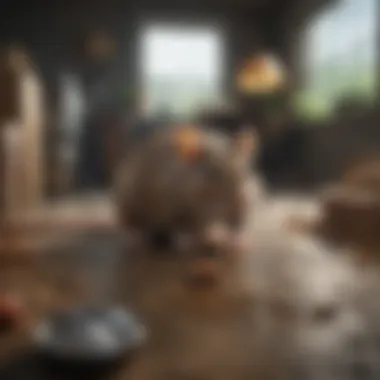Effective Rat Control Strategies in Pittsburgh


Intro
Rats have become a significant concern in urban environments, particularly in Pittsburgh, where their presence poses various challenges for homeowners. Understanding the behavior and biology of these pests is critical to formulating effective control strategies. This article provides a thorough examination of rat control measures, focusing on identification, prevention, and control methods. By adopting eco-friendly practices, residents can not only manage infestations but also promote a healthier living environment.
Understanding the Pest
Identification
Identifying rats is the first step in effective control. In Pittsburgh, the most common species found are the Norway rat and the Roof rat. The Norway rat has a robust body, typically brown or gray, and can reach up to 16 inches in length, excluding its tail. In contrast, the Roof rat is smaller and has a more slender body, usually black or dark brown. Both species can be distinguished by their tail length, color, and overall size.
Life Cycle
Understanding the life cycle of rats can aid in pest management efforts. Rats reproduce rapidly, with a female capable of producing several litters each year. A single litter can consist of up to twelve young. The gestation period is around three weeks. Young rats mature quickly, often reaching breeding age within two to three months. This rapid reproduction can lead to significant population growth if not properly managed.
Pest Prevention Strategies
Environment Modification
One effective way to control rat populations is to modify the environment to make it less hospitable. This includes:
- Eliminating food sources: Store food in sealed containers and clean up spills promptly.
- Reducing shelter options: Regularly clean up clutter, especially in outdoor spaces, and seal entry points in your home.
- Managing water sources: Repair leaky pipes and avoid leaving standing water.
Physical Barriers
Installing physical barriers can prevent rats from entering your property. Options include:
- Sealing holes: Use materials like steel wool or cement to block gaps and holes in walls, foundations, and around utility pipes.
- Building fences: A sturdy fence can deter rats from accessing your garden or yard, especially if buried a few inches underground.
- Screens: Cover air vents and openings with fine mesh screens to prevent entry.
Control Methods
Chemical Control
Chemical control methods can be employed but must be used with caution. Options like rodenticides are effective but can pose risks to pets and children. It's critical to follow safety instructions and consider consulting a pest control professional for the best results.
Biological Control
Biological control methods can offer more sustainable solutions. This includes:
- Predatory animals: Encourage the presence of natural predators, such as owls, which can help keep rat populations down.
- Traps: Use humane traps to catch and release rats without harm. This method minimizes environmental impact and can be effective in controlled areas.
"Sustainable pest management offers a dual benefit of controlling infestations while protecting our ecosystem."
By being informed and proactive, residents can effectively manage rat populations in Pittsburgh. Understanding the biology and behavior of these pests allows for a comprehensive approach to prevention and control.
Such strategies not only safeguard homes but also contribute to a healthier urban environment.
Understanding the Rat Problem in Pittsburgh
In Pittsburgh, the rat problem presents a complex and pressing concern for local communities. Understanding this issue is essential for effective management and prevention strategies. Rats, particularly the Norway and Roof types, have adapted well to urban environments. Their growth in population can lead to various complications, both ecologically and health-wise. Effective control strategies rely on a solid comprehension of the behaviors and tendencies of these pests.
Defining the Rat Species
The two main species that inhabit Pittsburgh include the Norway rat and the Roof rat. The Norway rat is larger, with a more robust body and a shorter tail. In contrast, Roof rats are smaller and more agile, often found in higher areas such as attics or trees. Being aware of the distinctions between these species is vital. Each possesses unique traits that influence their habitats and behaviors, leading to varied control needs.
- Norway Rats: Prefer ground-level burrowing and often create nests in sewers or basements.
- Roof Rats: Favor elevated environments and are more likely to invade homes through roofs or via utility lines.
Epidemiology of Rats in Urban Areas
Rats thrive in urban settings where food, water, and shelter are readily available. Pittsburgh's infrastructure, which includes alleys, basements, and numerous restaurant backlots, creates a favorable environment for these rodents. Their ability to reproduce rapidly exacerbates the problem. A female rat can produce up to 12 litters a year, with each litter containing 6-12 pups. This high reproductive rate leads to swift population growth, complicating control efforts.
Regular monitoring and data collection on rat sightings can inform local health departments and pest control agencies. Understanding the patterns of infestation provides insights into when and where the problem escalates, allowing for timely interventions.
Health Risks Associated with Rat Infestations
Rat infestations pose several health risks, which is a primary concern for homeowners. Rats are known carriers of various diseases, such as leptospirosis, salmonellosis, and hantavirus. These can be transmitted through direct contact, inhalation of contaminated dust, or via bites.
Furthermore, their waste can contaminate food and surfaces, posing additional health hazards. It is essential for residents to recognize signs of infestation early and to appropriately address these challenges.
"Effective rat control requires understanding the specific species involved, their behaviors, and the health risks they pose to effectively manage infestations in residential areas."
Addressing the rat problem in Pittsburgh is not only about extermination; it involves comprehensive management protocols that incorporate community actions, individual vigilance, and informed practices. Understanding the local rat problem thoroughly is practically the first step in safeguarding health and property.
Behavioral Patterns of Rats


Understanding the behavioral patterns of rats is crucial for effective control strategies. Such knowledge allows homeowners and pest management professionals to formulate targeted approaches to mitigate infestations. Rats exhibit distinct behaviors that relate closely to their feeding, breeding, and movement. By studying these behaviors, individuals can identify signs of rat populations and take measures sooner rather than later. This understanding also aids in developing preventive measures, as addressing the root causes of infestations is far more effective than merely responding to consequences.
Feeding Habits and Preferences
Rats are omnivorous creatures, with a wide range of dietary preferences. Their feeding habits greatly depend on their immediate environment and available resources. Generally, they are attracted to easily accessible food sources. They will consume grains, fruits, and even human food waste when available.
- Common Food Sources:
- Seeds and nuts
- Fruits and vegetables
- Pet food left outdoors
- Food scraps in garbage bins
Besides being opportunistic feeders, rats have a keen sense of smell, which they utilize to locate food items. They often forage at night, making it difficult for homeowners to catch them in the act. Understanding these habits can guide households in securing food sources. Keeping food in sealed containers and controlling waste will greatly diminish attractions for rats.
Breeding and Nesting Behavior
Rats breed rapidly under optimal conditions. A female rat can give birth to several litters each year, with each litter containing around 6 to 12 pups. This prolific breeding capability means a small rat problem can escalate quickly if not addressed.
- Nesting Locations: Rats prefer dark, hidden spaces for nesting. Common locations include:
- Attics
- Basements
- Wall cavities
- Cluttered storage areas
Understanding nesting behavior assists in identifying potential infestation sites. Homeowners should regularly inspect their properties for signs of nesting, such as droppings or shredded materials, similar to paper or fabric. Addressing clutter and sealing potential nesting sites can help in controlling rat populations before they begin to grow.
Movement and Activity Levels
Rats are primarily nocturnal animals, engaging in most of their activities during the night. Their movement patterns are strategic; they tend to travel along known paths, creating runways, and often avoid open spaces.
- Key Movement Behaviors:
- Following walls or edges to navigate.
- Using burrows and tunnels for shelter and travel.
By identifying these movement patterns, homeowners can take proactive measures. Placing traps along commonly traveled routes can yield better results than scattered placements. Monitoring activity levels also helps in determining the scale of the infestation. If signs of activity persist, it would be wise to consider professional assistance to explore further control methods.
Understanding the behavior of rats is essential in pest management. This knowledge informs preventative measures and facilitates more effective control strategies.
Environmental Factors Contributing to Rat Infestations
Understanding the environmental aspects that promote rat infestations is essential for effective control strategies. Pittsburgh's urban infrastructure and natural surroundings play a crucial role in creating suitable habitats for rats. Identifying these factors helps in implementing measures to mitigate the risk of infestations.
Urban Infrastructure and Waste Management
Rats thrive in environments where waste management practices are inadequate. In urban settings like Pittsburgh, overflowing dumpsters, littered streets, and improperly stored trash provide ample food sources for rats. Proper waste disposal is vital. Regular collection of trash, use of rodent-proof containers, and keeping garbage areas clean can significantly reduce food availability for these pests.
Moreover, some areas in Pittsburgh have older infrastructure. Cracks in sidewalks, gaps in loading docks, and poorly maintained buildings can serve as entry points for rats. Homeowners should inspect their properties for such vulnerabilities.
"Effective management of waste and urban infrastructure can drastically lower rat population densities within city limits."
Impact of Climate and Weather Patterns
Weather can influence rat reproductive patterns and survival rates. Mild winters in Pittsburgh may enable rat colonies to thrive undisturbed. During warmer months, increased rainfall can lead rats to search for drier shelter in nearby homes or businesses. Homeowners should be aware of seasonal changes and their impact.
Best practices include maintaining proper drainage systems to prevent flooding and the accumulation of standing water, which can attract rats. Ensure that gutters are clean and functioning well.
Role of Vegetation and Shelter
Vegetation acts as both a food source and shelter for rats. Overgrown yards or unkempt gardens provide perfect hiding places for rats. Dense bushes and tall grasses create ideal nesting spots and food availability, especially in urban areas.
To discourage rat habitation, homeowners should consider regular landscaping maintenance, including:
- Trimming back shrubs and trees
- Clearing debris and litter that may attract rodents
- Keeping grass mowed short
Also, avoid planting vegetation that bears fruit close to buildings, as it may attract rats. Thus, taking control of vegetation can help diminish the attractiveness of a property.
Understanding these environmental factors is crucial for homeowners dedicated to rat prevention. By tackling waste management, infrastructure integrity, climate impact, and vegetation control, effective rat control becomes achievable.
Preventative Measures for Rat Control
Preventative measures are vital in mitigating rat infestations, especially in urban environments like Pittsburgh. Understanding how to effectively deter these rodents can save homeowners from the challenges that come with infestations. Proactive strategies not only resolve potential issues but also create a less attractive environment for rats, limiting their access to food, shelter, and nesting areas.
Removing Attractants from Properties
One of the most critical steps in preventing rat infestations is the removal of attractants from properties. Rats are opportunistic feeders; they will seek food sources that are easily accessible. It is essential to regularly check and eliminate items such as pet food, birdseed, and understand what foods can lure these pests. Ensuring that garbage bins are secure and free of leaks can also significantly decrease the presence of odors that attract rats.
For homeowners, consider the following:


- Store food in airtight containers.
- Limit outdoor pet feeding. If you must feed pets outside, do so only during specific times and ensure that any leftover food is cleaned up immediately.
- Seal compost bins securely. Rats are attracted to decomposing organic matter.
Securing Food Sources
Securing food sources is essential in rat prevention. This involves both indoor and outdoor measures. Inside the home, ensure that food items are stored away and that surfaces are kept clean. Regularly cleaning up spills and crumbs can prevent attracting rats into your living space.
Outside, the same logic applies. Secure all outdoor food sources, including:
- BBQ grills: Keep them clean and stored properly.
- Fallen fruit: Regularly pick up and dispose of any fruit that falls from trees.
By addressing potential food sources, homeowners can significantly reduce the likelihood of attracting rats.
Effective Waste Disposal Practices
Household waste disposal practices play a significant role in rat control. Properly disposing of waste ensures that rats do not find easy access to food.
Consider following these waste disposal practices:
- Use rat-proof trash bins. Opt for bins with tight-fitting lids.
- Dispose of waste regularly. Do not let garbage accumulate over long periods.
- Recycling: Rinse out containers before placing them in recycling bins to avoid odors.
Keeping the property clean and maintaining effective waste disposal can dramatically reduce the risk of rat infestations.
Structural Modifications to Deter Entry
Lasting prevention of rat infestations often requires structural modifications to homes. Ensuring that entry points are sealed can greatly minimize the risk of rats finding their way inside.
Homeowners should assess their property for potential entry points including:
- Cracks in foundations: Fill cracks with appropriate sealants.
- Gaps around windows and doors: Ensure that all doors and windows close tightly.
- Ventilation openings: Consider installing mesh to limit access through vents.
By addressing these structural vulnerabilities, residents can create a physical barrier against rodent entry, making their properties less inviting to rats.
Overall, these proactive measures serve to fortify homes against rat infestations. Implementing such strategies can enhance the living environment for homeowners and mitigate health risks associated with these rodents.
Rodent Control Techniques
Effectively managing rodent populations is crucial for both urban health and community well-being. Rodent control techniques encompass a variety of methods, each with its advantages and drawbacks. Understanding these methods allows homeowners to select the most suitable approach in their specific context. It is important to weigh the options carefully, as some strategies may be more appropriate depending on the local environment and neighborhood characteristics.
Trapping Methods: Pros and Cons
Trapping remains one of the most traditional ways to control rat populations. Plastic snap traps and live traps are common choices among homeowners.
Pros:
- Immediate Results: Traps can provide quick feedback on rodent activity.
- Targeted Control: Unlike some chemical methods, traps allow for the capture of specific rodents without affecting other animals in the vicinity.
- No Poison Risks: Using traps minimizes the risk of unintended poisoning of pets or non-target wildlife.
Cons:
- Labor-Intensive: Traps require regular checking and maintenance to ensure effectiveness.
- Potential for Inhumane Outcomes: Some methods may lead to injury or distress for the captured rodent.
- Limited Capacity: Traps can only handle a specific number of rodents at a time, which may be inadequate for larger infestations.
Chemical Control Options
Chemical control methods include the use of rodenticides. These substances can effectively reduce rat populations when applied properly. However, users must exercise caution.
Important Considerations:
- Effectiveness: Chemical baits, such as bromadiolone or brodifacoum, can be very effective in eliminating rats.
- Safety Protocols: Careful usage according to manufacturer guidelines is necessary to prevent accidental poisoning of pets, children, or non-target species.
- Resistance Issues: Over time, rodents can develop resistance to specific chemicals, necessitating a change in control strategies.
Eco-Friendly Solutions in Rat Control
As awareness of environmental concerns grows, eco-friendly solutions in rat control are becoming increasingly relevant. Homeowners can adopt methods that are less harmful to the ecosystem.
Examples of Eco-Friendly Practices:
- Natural Deterrents: Using things like peppermint oil can help repel rats due to their strong sense of smell.
- Habitat Modification: Manually altering a landscape to eliminate shelter opportunities can make the area less attractive to rodents.
- Biological Control: Introducing natural predators, such as certain birds, can provide a long-term balance to rat populations without harming the environment.
"Addressing rodent issues through sustainable measures not only helps manage infestations but also protects our urban ecosystems."
By integrating multiple approaches to rodent control, including trapping, chemical measures, and eco-friendly options, homeowners in Pittsburgh can create an effective strategy tailored to their unique situations.
Community Engagement in Rat Management
Community engagement plays a vital role in rat management within Pittsburgh. Effective rat control strategies require not only actions taken by individuals but also active participation and cooperation among residents and local authorities. When communities come together, they create a collective approach that amplifies efforts to control rat populations.


Importance of Public Awareness Programs
Public awareness programs are essential in educating homeowners about rat infestations. These initiatives inform residents about the signs of rat activity and the importance of prevention. Understanding rat behaviors can significantly reduce attractants around homes. Programs can include workshops, informative flyers, and social media campaigns. The more informed residents are, the more likely they are to engage in effective prevention measures.
Collaborative Efforts among Residents
Collaboration among residents enhances the impact of rat management strategies. When neighbors work together, they can develop community-wide initiatives such as clean-up days, where they remove debris and waste that may attract rats. Regular meetings can also help share experiences and successes. This collective responsibility fosters a sense of ownership and accountability, making the community more resilient against infestations.
Role of Local Government and Agencies
Local government plays a crucial role in rat management through regulatory measures and resource allocation. Agencies can support public awareness programs and provide access to pest control resources. They can also establish enforcement policies for sanitation standards in residential areas. A proactive government response, including swift action to address reported infestations, is essential to maintain community safety.
"Collective action can result in a significant reduction in rat populations and improve overall community health."
The involvement of various stakeholders ensures a comprehensive strategy that addresses the needs and challenges of the community. By integrating efforts from both residents and local authorities, Pittsburgh can move toward successful rat management.
Legislation and Policies on Pest Control
Legislation and policies on pest control are critical to the broader conversation surrounding rat management in urban environments like Pittsburgh. These regulations serve not only to protect public health but also to maintain a balanced ecosystem. By understanding the various laws and guidelines that govern pest control, residents can better navigate their responsibilities and rights when it comes to managing rodent populations within their properties.
Effective legislation helps to create standards for pest control practices, ensuring that methods used are safe for both people and the environment. Compliance with these regulations minimizes the risk of harm associated with ineffective and harmful pest control strategies, such as the careless use of toxic substances. This can significantly reduce public safety hazards and health risks associated with rat infestations.
Pittsburgh’s Regulatory Framework
Pittsburgh has established a regulatory framework aimed at tackling pest issues with a strong focus on public health. The city regulations often specify the requirements for pest control services, including licensing, reporting, and the methods that can be used for rat control. Compliance with these regulations is not simply a formality; it ensures that pest management professionals operate within safe, ethical boundaries while employing methods that are proven to be effective.
Key elements of this framework include:
- Licensing Requirements: Pest control companies must hold valid licenses to ensure they have undergone proper training and adhere to legal standards.
- Record Keeping: Professionals are often required to maintain detailed reports on pest control activities. This transparency helps monitor effective strategies and reinforces accountability.
- Public Reporting: Residents are encouraged to report rat infestations. This data helps the city assess trends and allocate resources effectively.
Understanding these regulations is essential for homeowners. It allows them to make informed decisions on hiring pest control services and engaging in pest management activities themselves.
Best Practices for Compliance
Homeowners have a responsibility to comply with Pittsburgh's pest control regulations while managing the rat problems on their properties. Here are some best practices to consider:
- Hire Licensed Professionals: Always choose pest control services that are licensed and insured. This ensures that you are working with trained experts familiar with the local regulations.
- Stay Informed About Local Laws: Check for updates on pest control policies specific to your neighborhood. Local government websites often provide information.
- Keep Detailed Records: Maintain your own records of any pest control measures taken at your property. Documenting actions taken helps in accountability and can be useful in case further intervention is needed.
- Engage with Community Initiatives: Participating in community programs related to pest control can enhance awareness and collective action. This not only helps individual properties but also encourages responsible behavior across the community.
In summary, understanding Pittsburgh’s legislation and adopting best practices for compliance is essential for effective rat control. Not only does it help in managing infestations, but it also builds a safer and healthier environment for everyone.
Case Studies of Successful Rat Control Initiatives
Case studies of successful rat control initiatives play a crucial role in understanding and tackling the ever-present rat problem in urban areas like Pittsburgh. By analyzing different interventions, strategies can be refined based on what has effectively worked in similar settings. These real-world applications of pest management reveal insights into behavioral patterns, ecological impacts, and community engagement strategies that can inform future efforts. Moreover, they demonstrate the significance of tailored approaches that consider local circumstances and community involvement.
Analyzing Community-Led Projects
Community-led projects represent a powerful approach to rat control. These initiatives often mobilize local residents, creating awareness and promoting collaboration in the fight against infestations. One pertinent example may come from a neighborhood in Pittsburgh where residents formed a community task force specifically aimed at addressing rodent issues in their area.
Residents began by identifying hotspots where rat activity was prevalent. They worked together to track sightings, document conditions, and eliminate attractants through organized clean-up days. These grassroots efforts demonstrated that when community members come together, they can effectively reduce rat populations by enhancing the overall environment.
In addition to reducing rat numbers, such initiatives foster a sense of ownership among residents, promoting stewardship of their surroundings. They can also improve communication among neighbors, encouraging ongoing vigilance against potential problems. Communities that engage in collective action often realize long-lasting change, leading to reduced rat sightings and improved public health outcomes.
Evaluating Professional Interventions
While community initiatives are critical, professional interventions also provide valuable insights into effective rat control. Pest control companies in Pittsburgh have had successful targeted campaigns that demonstrate the impact of expertise in managing infestations. Professional evaluations often include comprehensive inspections and strategically designed control tactics.
For instance, a pest control company might employ a combination of trapping and exclusion techniques based on initial assessments. These techniques take into consideration the specific building conditions and environmental factors contributing to the rat problem. By removing entry points and offering continuous monitoring, professionals can help maintain reduced rat populations over time.
Effective interventions built from research and experience are key to successful rodent control initiatives.
Ultimately, evaluating the success of professional interventions allows for learning and improvement in methodology. It also underscores the importance of using evidence-based practices tailored to local conditions, leading to sustainable solutions for rat control.
In summary, case studies provide a valuable resource for developing effective rodent management strategies. Both community-led and professional interventions offer unique insights into controlling rat populations. Together, these initiatives can contribute significantly to sustainable rat control in Pittsburgh.
Future Directions in Rat Control Research
The field of rat control is constantly evolving. Understanding the future directions in rat control research is pivotal for developing innovative strategies that can effectively manage and reduce rat populations. This forward-thinking approach is crucial, especially in urban areas like Pittsburgh, where rat infestations pose significant health risks and environmental challenges. Emerging research can offer insights into more efficient pest management practices, which are essential for homeowners and local communities seeking sustainable solutions.
Emerging Technologies in Pest Management
As technology advances, so do the methods of pest control. One key area of exploration is the use of digital monitoring systems. These systems employ sensors to detect and track rat movements, allowing for targeted interventions. For homes and businesses, this means being able to monitor rat activity in real-time, making response efforts timely and efficient.
Other technologies include the development of genetic tools aimed at disrupting rat reproduction. Techniques like gene-editing could potentially limit rat populations in areas where traditional methods fail. Additionally, the integration of artificial intelligence can help in analyzing data collected from pest control efforts, enhancing decision-making processes.
"Investing in technology for pest management not only boosts effectiveness but also aligns with modern practices that urban environments require."
Sustainable Practices for Urban Areas
Sustainability is becoming increasingly important in urban pest management. Sustainable practices are designed to minimize environmental impact while still addressing the rat problem. For example, using organic pest repellents can effectively deter rats without introducing harmful chemicals into local ecosystems.
Moreover, community gardening and landscaping programs can be adapted to reduce infestation risks. Residents can engage in practices like planting certain types of vegetation that are less appealing to rats, thus managing food sources in their vicinity. Education on regular property maintenance, such as sealing cracks and removing debris, can significantly contribute to reducing harborage for these pests.







